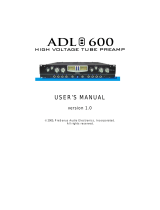
WARRANTY
PreSonus Limited Warranty
PreSonus Audio Electronics Inc. warrants this product to be free of defects in material and
workmanship for a period of one year from the date of original retail purchase. This warranty is
enforceable only by the original retail purchaser. To be protected by this warranty, the purchaser
must complete and return the enclosed warranty card within 14 days of purchase. During the
warranty period PreSonus shall, at its sole and absolute option, either repair or replace, free of
charge, any product that proves to be defective on inspection by PreSonus or its authorized
service representative. To obtain warranty service, the purchaser must first call or write
PreSonus at the address and telephone number printed below to obtain a Return Authorization
Number and instructions of where to return the unit for service. All inquiries must be accompanied
by a description of the problem. All authorized returns must be sent to the PreSonus repair facility
postage prepaid, insured and properly packaged. PreSonus reserves the right to update any unit
returned for repair. PreSonus reserves the right to change or improve the design of the product at
any time without prior notice. This warranty does not cover claims for damage due to abuse,
neglect, alteration or attempted repair by unauthorized personnel, and is limited to failures arising
during normal use that are due to defects in material or workmanship in the product. Any implied
warranties, including implied warranties of merchantability and fitness for a particular purpose, are
limited in duration to the length of this limited warranty. Some states do not allow limitations on how
long an implied warranty lasts, so the above limitation may not apply to you. In no event will
PreSonus be liable for incidental, consequential or other damages resulting from the breach of any
express or implied warranty, including , among other things, damage to property, damage based on
inconvenience or on loss of use of the product, and, to the extent permitted by law, damages for
personal injury. Some states do not allow the exclusion of limitation of incidental or consequential
damages, so the above limitation or exclusion may not apply to you. This warranty gives you specific
legal rights, and you may also have other rights which vary form state to state. This warranty only
applies to products sold and used in the United States of America. For warranty information in all
other countries please refer to your local distributor.
PreSonus Audio Electronics, Inc.
7257 Florida Blvd.
Baton Rouge, LA 70806
(225) 216-7887
? 2003, PreSonus Audio Electronics, Incorporated. All rights reserved.























